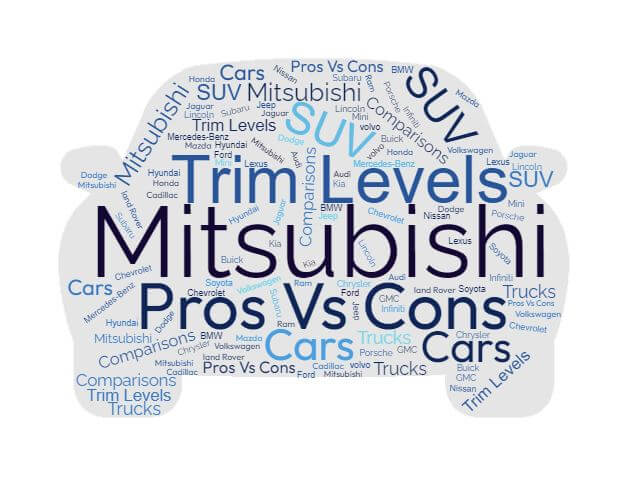Mitsubishi

About Mistsubishi
Mitsubishi can trace its origins back all the way to 1870. It was originally a shipping firm and then expanded into numerous other areas, including coal mining, ship building, and even marine insurance. The first Mitsubishi car was constructed in 1917. Christened the Model A, it was a large, hand-built sedan based loosely on the Fiat Tipo 3. It was very expensive to produce, though, and only a handful were ever made.
At the end of World War II, Mitsubishi was a huge, family-controlled conglomerate called a zaibatsu. It had its hands in nearly every major type of industry in the country. The Allied powers who oversaw postwar Japan dismantled the zaibatsu into several smaller companies in 1950.
In 1960, Mitsubishi launched its first significant Japanese market car -- the 500. That was followed by a succession of small, affordable vehicles that catered to the country's emerging middle class.
By the late 1960s, Mitsubishi was looking to expand into the U.S. In order to "get their feet wet," so to speak, the Japanese firm negotiated a deal with Chrysler. The result of this deal was the Dodge Colt. A "captive import," the Colt was actually just the Mitsubishi Galant with new badges and a few other minor changes slapped on. This deal helped Mitsubishi dramatically increase its annual production.
1982 - The First Official Mitsubishi Goes on SaleBy the end of the 1970s, the deal with Chrysler had run its course. The American company was increasingly interested in selling its own low-cost subcompacts, rather than rebadged versions of someone else's. For their part, Mitsubishi felt like they needed more control over their U.S. operations.
The time was right for the Japanese company to make its official stateside debut. It launched in 1982 with an initial network of 70 dealerships in 22 states. The launch lineup consisted of the Starion and Cordia coupes and the Tredia sedan.
Despite their previous falling-out, Chrysler and Mitsubishi again decided to join forces in the mid-1980s. Their new partnership resulted in Diamond Star Motors, a joint manufacturing plant located in Normal, Illinois. Diamond Star Motor's first project was a sporty front-wheel-drive coupe. With minor differences, it was sold under three different names: the Mitsubishi Eclipse, Eagle Talon, and Plymouth Laser.
1989 - A Brand on the RiseThe Mitsubishi Galant VR-4 sedan was awarded Motor Trend's Import Car of the Year Award for 1989. It was a welcome dose of good press for the brand, which had a somewhat mixed reputation in the U.S. at that time. The high-tech Galant VR-4 itself did a good job of casting Mitsubishi as an exciting, high-tech innovator. The midsize sedan boasted an active electronic suspension system called ECS. This ahead-of-its time technology automatically adjusted ride height and shock dampening in response to the road surface and the driver's inputs.
1990 - Kicking-Off the 1990s With a BangThe 1990s were, without a doubt, Mitsubishi's heyday. During that period, it emerged as a legitimate, performance-focused alternative to Honda, Toyota, and Nissan. Two cars in particular were responsible for casting the brand in an exciting, sporty light: the Eclipse and the 3000GT.
The Eclipse was an affordable, front- or all-wheel-drive sports coupe. A favorite of budget tuners and would-be street racers, it is considered a defining vehicle of the sport compact craze that dominated the '90s and early 2000s.
The 3000GT, on the other hand, was a lust-worthy high-performance sports car. Comparatively expensive, it featured a swoopy, head-turning body a long list of advanced technologies, including full-time all-wheel drive and four-wheel steering. While a reputation for being fragile has tarnished its legacy somewhat, the 3000GT was a memorable, innovative effort and a genuine "dream car" for many people who grew up in the 90s.
Thanks in no small part to video games like Sony's "Gran Turismo" and animated series like "Initial D," Japanese cars were exceedingly popular among young enthusiasts at the turn of the millennium. The Mitsubishi Lancer Evolution was one of the most desirable, in part because it was so inaccessible. Prior to 2003, the "Evo," as it was called, was never available in the U.S. That year, though, Mitsubishi finally brought its "rally car for the streets" to American shores. Featuring a high-revving, turbo-charged V-6, a stiff sport suspension, and a wildly extroverted exterior, the car was a big hit and generated a lot of excitement for the brand.
2015: The End of an Era?
Sadly, it appears that Mitsubishi's best days are behind it, at least as far as the U.S. market is concerned. The Lancer Evolution will go out of production after the 2015 model year. The fourth-generation Eclipse -- which was considered disappointing by fans of the more performance-oriented earlier versions -- was discontinued in 2012. The brand's remaining lineup lacks anything very interesting or distinctive. With sales on a long, steady decline, there has even been talk about Mitsubishi dropping out of the U.S. market permanently. No matter what happens in the long-run, the brand will always be remembered by car enthusiasts for exciting, innovative vehicles like the 3000GT and the Lancer Evolution.






